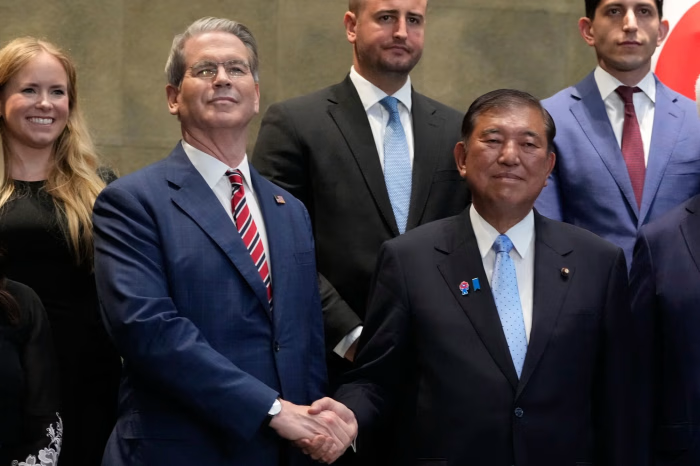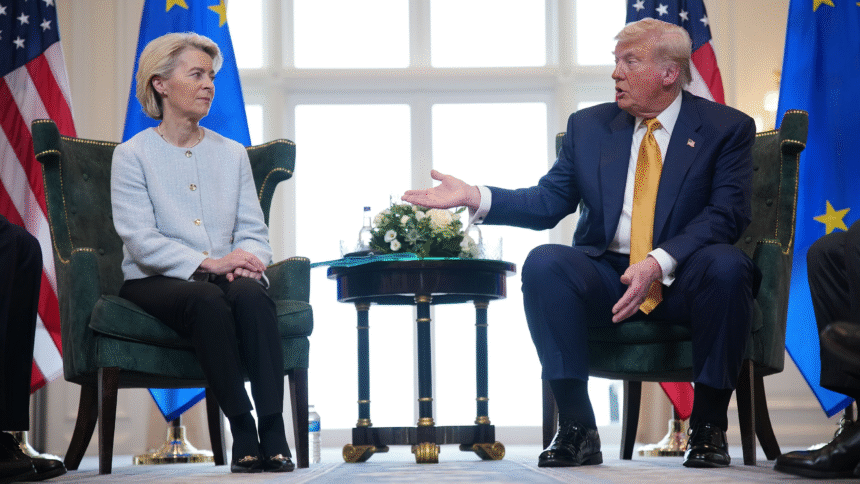Trump Clinches Historic $1.35 Trillion EU Mega Deal: 15% Tariff Slash, $750 Billion Energy Pact, $600 Billion Investment Surge
Donald Trump strikes a historic $1.35 trillion trade deal with the EU, slashing tariffs to 15%, securing a $750 billion energy agreement, and unlocking $600 billion in new investments
The United States and the European Union have reached a last-minute trade agreement that will impose a 15% tariff on EU goods entering the US, replacing the previously threatened 30% rate. The deal, reached just ahead of the August 1 deadline, was announced by President Donald Trump and European Commission President Ursula von der Leyen after a high-stakes meeting at Trump’s Turnberry golf resort in Scotland.
“It was a very interesting negotiation. I think it’s going to be great for both parties,” Trump said.
President Trump noted the long-standing friction in trade relations between the US and Europe, saying: “We’ve had a hard time with trade with Europe, a very hard time.” “I think the main sticking point is fairness.”
Under the deal, the US will impose a baseline 15% tariff on EU exports — the same level Japan recently agreed to — including autos, which were previously taxed at 25%.
“We are agreeing that the tariff straight across, for automobiles and everything else, will be a straight across tariff of 15 percent,” Trump confirmed.
As part of the agreement, the EU has committed to purchasing $750 billion worth of US energy and investing $600 billion more into the American economy.
Trump called the outcome “a good deal for everybody,” while von der Leyen added: “It will bring stability. It will bring predictability. That’s very important for our businesses on both sides of the Atlantic.”
The agreement reportedly mirrors the recent .S-Japan deal announced earlier in the week, which also featured a 15% import duty and avoided previously threatened higher tariffs
US Commerce Secretary Howard Lutnick emphasised the urgency to push both sides to reach a consensus: “No extensions, no more grace periods. August 1, the tariffs are set, they’ll go into place, Customs will start collecting the money and off we go.”
In a landmark development poised to redefine transatlantic trade, former U.S. President Donald Trump has reportedly finalized a historic trade deal with the European Union, slashing tariffs down to 15% and unlocking a combined $1.35 trillion in energy and investment commitments. The breakthrough agreement—hailed as a game-changer for global commerce—includes a $750 billion energy pact and a $600 billion investment push from European partners into U.S. infrastructure, tech, and manufacturing sectors.
This strategic move marks one of the most aggressive trade negotiations in modern economic history, with Trump once again positioning himself as a shrewd dealmaker ahead of the 2024 election cycle. The deal comes at a time of heightened geopolitical tensions, global inflation pressures, and supply chain realignments—particularly as the U.S. and EU both seek to reduce dependence on China and stabilize energy markets post-Russia’s invasion of Ukraine.

In a major departure from the trade war dynamics seen during Trump’s first term, the former president managed to negotiate a reduction of cross-border tariffs to a uniform 15%—a move that benefits both American exporters and European manufacturers. This move is expected to dramatically reduce the cost of transatlantic goods and boost competitiveness for small- and medium-sized enterprises on both sides of the Atlantic.
At the heart of the agreement is a sweeping energy deal valued at $750 billion. The pact will see European countries significantly increase their imports of American liquefied natural gas (LNG), crude oil, and renewable technologies, while also facilitating joint ventures in nuclear and hydrogen development. Analysts believe this could rewire global energy flows and reduce EU dependency on Russian and Middle Eastern suppliers.
European investment firms and sovereign wealth funds have committed to injecting over $600 billion into key sectors across the United States. These investments will be directed toward advanced manufacturing, AI and semiconductor technology, green energy, transportation infrastructure, and logistics. The funding is expected to create hundreds of thousands of jobs and help revitalize America’s industrial base.
Experts say this deal could serve as a blueprint for future economic alliances, particularly among Western democracies seeking to build resilient trade networks in an increasingly fragmented global economy. By prioritizing shared interests in energy security, investment growth, and tariff normalization, the U.S.-EU accord may also help reduce inflationary pressure by easing supply bottlenecks and lowering import costs.
From a political standpoint, the timing of this deal is crucial. With Trump actively campaigning for a 2024 presidential comeback, this agreement gives him a substantial economic talking point and the ability to contrast his global leadership style with the current Biden administration. Critics, however, caution that implementation remains key and that several EU member states may demand additional safeguards before ratification.
Global stock markets reacted positively to the announcement, with the S&P 500 and Euro Stoxx 50 both rising sharply. Energy stocks, in particular, surged on news of the $750 billion transatlantic pact. The dollar also strengthened against the euro, reflecting investor optimism about America’s energy dominance and capital inflows.
With a colossal $1.35 trillion deal on the table, Donald Trump has once again reasserted his role as a master negotiator on the world stage. Whether this landmark pact delivers the long-term structural changes it promises will depend on follow-through from both Washington and Brussels—but for now, the numbers are doing all the talking.








